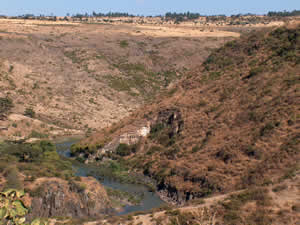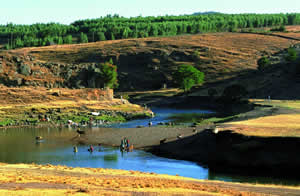- | Home
- | Melka Kunture
- | History of Research
- | Museum
- | For Scientists
- | Bibliography
- | Culture 2000 |
Introduction
Melka Kunture lies in the upper Awash valley, 50 km south of Addis Abeba. The site, discovered by Gerard Dekker in 1963, was surveyed by Gérard Bailloud in 1964, and then systematically explored by a French mission directed by Jean Chavaillon (1965-1982 / 1993-1995), and subsequently, since 1999, by an Italian mission directed by Marcello Piperno for the Italian Ministry of Foreign Affairs and the University of Rome “La Sapienza”, in agreement with the Authority for Research and Conservation of Cultural Heritage of the Ethiopian Ministry of Culture and Tourism and the Oromia Culture and Tourism Bureau.
The Awash basin
The Awash basin extends for about 3000 km² at a height between 2500 and 2000 m a.s.l. It is delimited by several Pliocene volcanoes, the largest being the Wachacha and the Furi to the north, and the Boti and Agoïabi to the south. It is bordered to the east by the Ethiopian rift, part of the great rift system of eastern Africa. Fluvial sedimentation (pebbles, gravel, sand, and clay) was frequently interrupted by volcanic activity, whose products are important markers for stratigraphic correlations between the different archaeological sequences identified so far. Over 70 archaeological levels have been discovered so far, and more or less wide extensions of about 30 of them have been excavated.
The Awash Gorges
The Oldowan
The sequence begins with the Oldowan site of Karre, about 1.7 million years old, which can be correlated to level B of Gombore I, on the right bank of the Awash. A probably contemporaneous Oldowan site is documented at Garba IV. The magneto-stratigraphic sequence of Jaramillo lies between Tuff A, which overlies the Oldowan sites, and Tuff B, which is dated between 1.0 and 0.84 Myr. Some important sites, such as Garba XII and Simbiro III, datable to a transitional phase from the late Oldowan to the Early Acheulean (Garba XII) or to an archaic phase of the Acheulean (Simbiro), also lie within this chronological span.
Melka Garba
The Acheulean and the Middle Stone Age
A later phase of the African Acheulean is well represented by several sites in the area of Gombore II (dated to about 0.8 Myr). The latest Acheulean site is Garba I, dated to ca. 0.5 Myr, while the end of this long sequence is represented, at Melka Kunture, by the site of Garba III, approximately dated to 0.2 Myr, which can be regarded as a transitional site towards the Middle Stone Age. Some of the above-listed levels yielded hominids remains: a humerus fragment of H. cf. erectus at Gombore I; a hemimandible of a H. cf. erectus child at Garba IV; two H. erectus skull fragments at Gombore II; and three archaic H. sapiens skull fragments at Garba III.
Late Stone Age
The East African Late Stone Age is poorly documented at Melka Kunture, being represented so far by some finds at Wofi and Kella. A little less than 7 km from Melka Kunture, in a site known as Balchit, are imposing outcrops of obsidian. As recent analyses from samples from several sites in Melka Kunture bear out, these outcrops were used, ever since the earliest Oldowan phases, as an important source of raw material. The exploitation of obsidian in the Melka region went on until historical times, leaving numerous and extensive accumulations of tens of thousands of blades, cores, and scars of this volcanic rock.
Paleontological and paleobotanical investigations
Paleontological and paleobotanical investigations have provided a quite satisfactory reconstruction of the environmental changes in this area of the Ethiopian plateau during the Lower and Middle Pleistocene, indicating that climatic variations within an essentially unchanged savannah environment determined oscillations in the expansion of arboreal species and in animal populations. In drier periods, bovids and equids were more abundant, whereas in more humid phases they were partially replaced by species better suited to life in a forested savannah, such as hippopotamus, warthogs, and elephants.

Melka Kunture